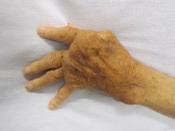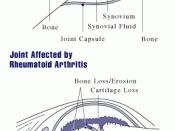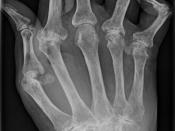Rheumatoid arthritis, commonly referred to as RA, affects about one percent of the world's population. It is an autoimmune disease in which the immune system attacks normal, healthy tissues and cells, releasing enzymes that attack surrounding tissues. RA typically affects the lining of joints, but it can affect the membranes lining blood vessels, heart, and lungs may also become inflamed. Joints and other affected areas become inflamed, swell, and cause pain.
Early in the disease, people may notice general fatigue, stiffness, and soreness. Swelling and pain may occur in joints on both sides of the body and usually start in the hands and feet. RA affects hand joints, elbows, shoulders, neck, knees, hips, and ankles. It usually persists over long periods of time, but some people go into remission, usually within two years of the diagnosis of the disease. Other symptoms may include loss of appetite, anemia, severe weight loss, muscle fatigue, warm joints, and swelling.
Rheumatoid arthritis is often difficult to diagnose. There is no single test for diagnosing RA, and it's often misdiagnosed as Lyme disease. The Latex test is used to diagnose RA. The test detects the rheumatoid factor present in the blood. The rheumatoid factor is an antibody produced in response to inflammation, and is most often present in patients with RA as their conditions progress. Rheumatoid factor is also found in patients with chronic infection, but high levels are often seen in severe cases of RA. The diagnostic criteria of the American College of Rheumatology state that four out of seven symptoms must be present for the diagnosis of RA to be made. Symptoms such as swelling and stiffness must be present for at least six weeks before the diagnosis is considered certain.
RA is also diagnosed using medical history, a doctor's examination...


